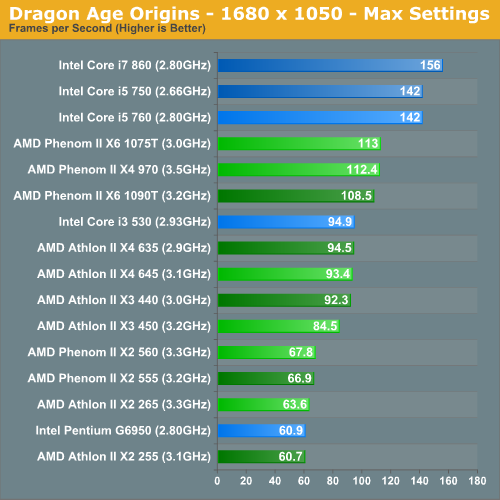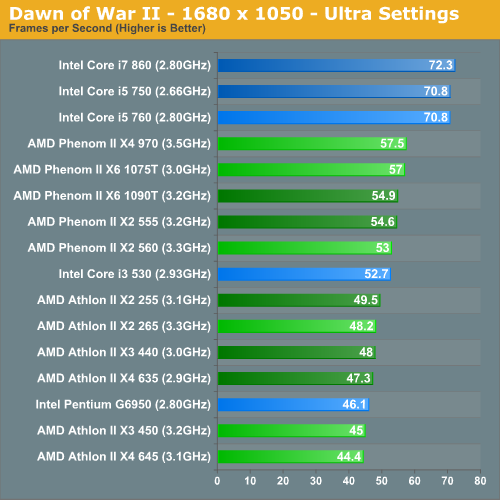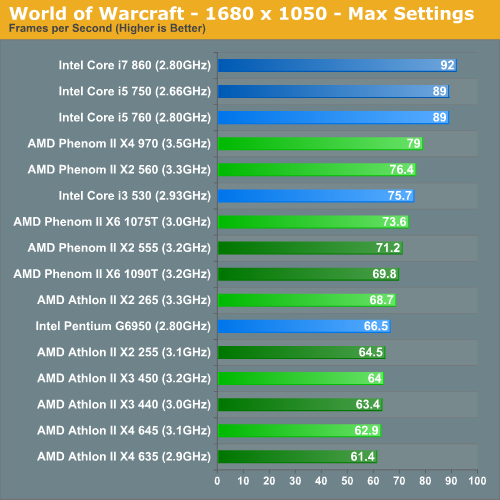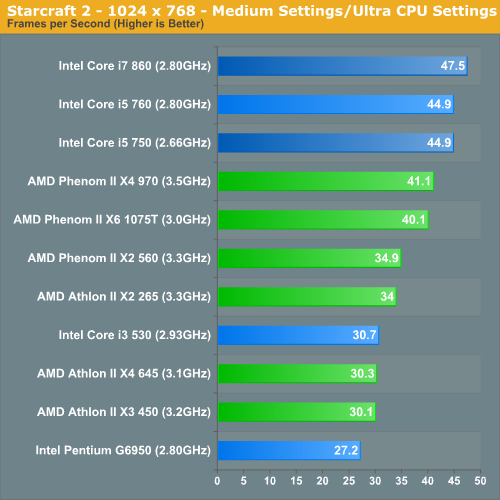AMD's Fall Refresh: New Phenom II and Athlon II CPUs Balance Price and Performance
by Anand Lal Shimpi on September 21, 2010 2:52 AM EST- Posted in
- CPUs
- AMD
- Phenom II X6
- Athlon II
Sonar 8 Audio Mixing Performance
In our only digital audio production test we take a multi-track recording and export it to a WAV file using Sonar 8. The benchmark isn't very well threaded and prefers two very fast cores to several slower ones:

As I mentioned before, this is the biggest issue with AMD's lineup. If you're running applications that can't use the extra cores, AMD's advantage typically disappears.
Gaming Performance

At the high end, AMD's Phenom II X6 and X4 lose to the similarly priced Lynnfields. In the middle the Athlon II X4 645 and Athlon II X3 450 do very well.

With the exception of the Phenom II X6 and X4 processors, AMD is generally competitive here. Intel maintains the performance advantage above $200. There's an unusual amount of variance in our tests here (particularly old vs. new AMD results). The variance appears to be caused by the platform shift as we moved all of our AMD testing to the same 890GX motherboard. The change in performance under Dawn of War II however doesn't really change the standings.

WoW performance is governed by two threads thus negating any core count advantage. AMD loses at the high end but is competitive around the $100 mark.

Starcraft 2 performance is something we're beginning to look at. Again we have a situation where a game doesn't use more than two cores. The Phenom IIs are slower than Lynnfield, while the multi-core Athlon IIs do well against their competitors. If you're building a fast Starcraft 2 box that doesn't have to do anything else, the dual-core CPUs do better here.










98 Comments
View All Comments
Stuka87 - Tuesday, September 21, 2010 - link
I would really like to see a "Bang for your Buck" graph. In many test, AMD comes close to the i7, but the i7 cost more. So when you do a performance per dollar ratio, AMD may come out on par, or maybe even ahead in some cases.I also find it interesting that some of the Phenom II x4's have a lower power consumption at idle than the X2's. I realize the X2's use the same silicon, but with the cores turned off, shouldn't they use less?
Great over all article as always though :)
Zanfib - Tuesday, September 21, 2010 - link
Anand, as always great work,You write "Bulldozer is out of the question however, AM3+ chips aren’t backwards compatible with AM3 motherboards (although the opposite is true, you will be able to use your 970 in an AM3+ motherboard)."
Is this the definitive truth? :-)
I have read a lot of people guessing whether AMD will have AM3 compatibile Bulldozer modes available, or only AM3+ (AM3Rev...).
Thanks!
Anand Lal Shimpi - Tuesday, September 21, 2010 - link
This information came directly from AMD :) Not saying it's 100%, just saying it's the source.You'll see AM3+ motherboards in advance of the Bulldozer client launch so you'll be able to buy a new board for your CPU and then later drop in a Bulldozer.
Take care,
Anand
stmok - Tuesday, September 21, 2010 - link
Yeah, its true.Bulldozer isn't backward compatible with current Socket AM3 motherboards.
But Socket AM3+ motherboards will be backward compatible with existing AM3 processors.
Mentioned on a number of sites...
=> http://www.extremetech.com/article2/0,2845,2368186...
"AMD also told us that it will introduce a new AM3+ socket for consumer versions of Bulldozer CPUs. AM2 and AM3 processors will work in the AM3+ socket, but Bulldozer chips will not work in non-AM3+ motherboards."
=> http://www.rage3d.com/articles/amd_heat_vision_hot...
"For the desktop, the Zambezi processor is good news and bad news. The good news is it's an 8 core product, the bad news is it needs a new socket - AM3r, or AM3+. This is an electrical upgrade of the AM3 platform, to provide the power phases and planes/states required by the power gating features of Zambezi. As you might have guessed from the name, this socket is backwards compatible with existing AM3 processors, so you'll be able to piecemeal your upgrade - motherboard for your birthday, CPU for Christmas, or however your upgrade cycle works."
=> http://www.xtremesystems.org/forums/showpost.php?p...
"When we initially set out on the path to Bulldozer we were hoping for AM3 compatibility, but further along the process we realized that we had a choice to make based on some of the features that we wanted to bring with Bulldozer. We could either provide AM3 support and lose some of the capabilities of the new Bulldozer architecture or, we could choose the AM3+ socket which would allow the Bulldozer-base Zambezi to have greater performance and capability.
The majority of the computer buying public will not upgrade their processors, but enthusiasts do. When we did the analysis it was clear that the customers who were most likely to upgrade an AM3 motherboard to a Bulldozer would want the features and capability that would only be delivered in the new AM3+ sockets. A classic Catch-22.
Why not do both you ask? Just make a second model that only works in AM3? First, because that would greatly increase the cost and infrastructure of bringing the product to market, which would drive up the cost of the product (for both AMD and its partners). Secondly, adding an additional product would double the time involved in many of the development steps.
So in the end, delivering an AM3 capability would bring you a less featured product that was more expensive and later to market. Instead we chose the path of the AM3+ socket, which is a path that we hope will bring you a better priced product, with greater performance and more features - on time.
When we looked at the market for AM3 upgrades, it was clear that the folks most interested in an AM3-based product were the enthusiasts. This is one set of customers that we know are not willing to settle for second best when it comes to performance, so we definitely needed to ensure that our new architecture would meet their demanding needs, for both high performance and overclockability. We believe they will see that in AM3+."
Taft12 - Tuesday, September 21, 2010 - link
<i>But Socket AM3+ motherboards will be backward compatible with existing AM3 processors.</i>This was not true from AM2+ to AM3, and I don't believe for a second this is true across the board from AM3 to AM3+. Many motherboard manufacturers (even top tier ones) will not bother with BIOS updates to older boards that went EOL some time ago.
If your board has a 7xx or Nvidia chipset and has been EOL for a year, I wouldn't count on anything. Better safe than sorry.
JMC2000 - Tuesday, September 21, 2010 - link
"This was not true from AM2+ to AM3, and I don't believe for a second this is true across the board from AM3 to AM3+. Many motherboard manufacturers (even top tier ones) will not bother with BIOS updates to older boards that went EOL some time ago."From what I read, it is not the same situation before: Most AM2+ boards can run AM3 cpus, pending on BIOS support, AM2+ cpus will not work on AM3 boards, because they do not have a DDR3 memory controller. AM3+ (AM3r2) cpus will not work on AM3 boards, because the power gating logic on Bulldozer based cpus is not compatible with the power plane setup on AM3.
Basically, AM3 cpus are both backwards and forwards compatible with previous and upcoming sockets in their line.
Dark_Archonis - Tuesday, September 21, 2010 - link
Yes, for AMD owners, the party is over. Bulldozer is not compatible with AM3 motherboards, so anyone who wants Bulldozer will need a new motherboard.Madmanden - Wednesday, September 22, 2010 - link
The party's over for both AMD and Intel users. They both have to get a new board for upcoming CPUs.mike23 - Thursday, September 23, 2010 - link
this is a very good point.Benchmarks that cover something more than common tasks (that low and mid range processors do adequately every day) would be helpful.
With regard to the competition issue...It's blatantly obvious where Intel sees AMD as competition. All the way up to the 4 core I7 series. Beyond that, no competition and ridiculous prices.
If not for AMD's efforts, you wouldn't have the I5's and I7s in the 200-300+ range right now. So, yes, they are providing strong competition in certain market segments.
DMisner - Tuesday, September 21, 2010 - link
Would you consider doing something of a Folding@Home benchmark, possibly running the SMP client for a day or something and seeing what kind of PPD figures you would get with these processors?Seems like F@H is really what I do most with my computers.